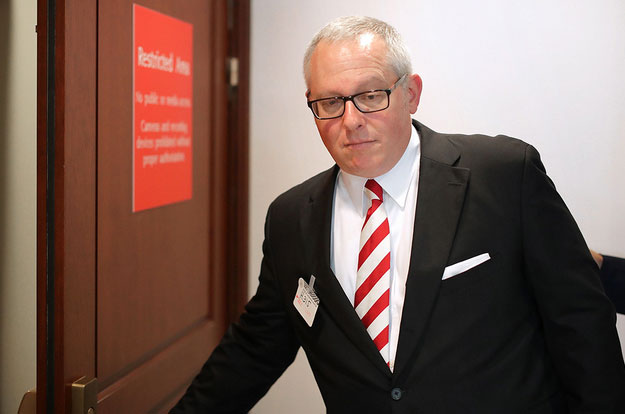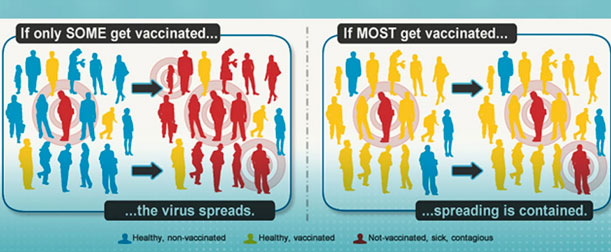‘We want them infected’: Trump appointee demanded ‘herd immunity’
Herd Immunity has never been a valid scientific approach to an impending pandemic. Scientifically, it has generally referred to vaccination objectives. Yet as Covid-19 was making itself felt outside of the northeast this past summer, President Donald Trump’s campaign embraced herd immunity as a winning re-election strategy and, by extension, the plan they would push to fight the virus. The Trump crowd then went into high gear with their messaging that had jumped the Atlantic.
With his usual linguistic Jiu–Jitsu, Trump even referred to it as herd mentality – an appropriate description of his support-magisterium in government and media that takes his cues and runs with his message, regardless of the costs. President Trump’s former advisor to the Health and Human Services Department (HHS) then called for Americans to open themselves up to infection by the killer viral pathogen – as a means of fighting it.

In recently-revealed emails, on July 4, 2020, former HHS science adviser Paul Alexander wrote to his boss, HHS assistant secretary for public affairs Michael Caputo, and six other senior officials, demanding the adoption of herd immunity as national policy. This meant doing nothing and letting the virus take its course.
We want them infected. There is no other way, we need to establish herd, and it only comes about by allowing the non-high-risk groups to expose themselves to the virus. PERIOD. Infants, kids, teens, young people, young adults, middle-aged with no conditions, etc. have zero to little risk….so we use them to develop herd…we want them infected
Former HHS science adviser Paul Alexander
Herd Immunity Defined
Herd immunity happens when a virus can no longer spread because its potential host population is now mostly immune to its transmission. Having already been infected by the virus and having survived it, the host population is no longer contagious. An “immune” host – one that is not necessarily immune to the virus but immune to its contagious effects – becomes an unwilling viral transmitter.
A viral agent is at once a “Selfish Gene” [Richard Dawkins, 1976] and a smart gene in search of willing hosts. So, it dies or remains dormant when it lacks the means (host cells) to self-propagate. So once a sufficient level of the population has been left “immune” (unable to transmit) by the virus’ initial wave, new waves of outbreaks become negligible. For example, the few people who may catch Chickenpox today are the few non-vaccinated people without the “immunity” (antibodies) that the vaccine generates.
You don’t need everyone in the population to be immune — you just need enough people to be immune.
Caroline Buckee, epidemiologist at Harvard T.H. Chan School of Public Health in Boston, Massachusetts.
More Appropriately – “Herd Protection of The Vulnerable”

So, herd immunity has traditionally been the objective of global vaccination programs that are tested and controlled because vaccines protect both the vaccinated individual and the community by building up “herd capacity” to prevent the spread. It is more appropriately deemed herd protection by many scientists because it prevents the majorly healthy population (now no longer contagious) from transmitting a virus to the immuno-compromised population who are not able to be vaccinated and who might not survive an infection, as well as the healthy “free-riders who benefit from the protection provided by a well-vaccinated society, without contributing to herd immunity themselves
Allowing a virus with many unknown variables, like its mutational capacities, viral load variations, transmission means (mouth or nose) effects, and so on, to run amok has never been the subject or objective of the herd immunity thought of by serious clinicians. That would be engendering negligent manslaughter on a massive scale. It is further ironic that this idea received serious consideration in a country where many states charge the participant in a petty theft for the actual murder of his friend who was shot by the victim of their petty larceny as they fled.
Indigenous Cultures Without Herd Immunity

Indigenous cultures are the best examples of herd immunity or its lack thereof. The Sentinelese on the Andaman Islands in India and numerous indigenous hunter-gatherer tribes in Brazil’s rainforests, for instance, are averse to external human contact by nurture and nature. Socially (neurologically), their unfamiliarity with outsiders sends them into a “fight or flight” state on any encounter with outsiders – the way things were in our distant past, but not so long ago for them.
But most importantly, their genetic predisposition seeks refuge from foreign viruses and bacterias, for they have no immunity. It is also the reason why governments protect them from outside infringements. Free of vaccinations and the herd immunity that we have developed over time, their DNA chains have no protection for, no immunity against the viruses we carry. Contact with outsiders would wipe them out the way the coronavirus wipes out those among us with dire comorbidities.
This is a historical fact, informed by Franciso Pizarro’s encounter with the Peruvians, Hernán Cortés’ encounter with the Mexicans, and Britain’s Captain Cook’s encounter with the Polynesians – among many available examples. Indeed, writer Jared Diamond’s book on Spain’s means of conquering the Americas was appropriately entitled “Guns, Germs, and Steel.”
No Talk of Herd Immunity in Britain During “Mad Cow” or “Foot & Mouth” Diseases
A quick step down memory lane shows the extent to which the notion of herd immunity in battling the coronavirus was abject junk science and outright preposterous. Britain was plagued with iterations of Bovine Spongiform (“Mad Cow Disease”) in the 1980s and 1990s. Toward the end of the millennium, “Hand, Foot and Mouth Disease” had also struck. In each of the various outbreaks, the only animals to survive were the uninfected that were isolated from the infected. The authorities then culled the infected en masse.
For the same reason, exposure to death means possible or likely death of millions of people – a form of social eugenics that might kill the elderly, the infirmed, those with co-morbidities, and even the healthy receiving massive viral loads. So, it was even more surprising that Britain had even toyed with this idea for humans when it had taken no such chances with its animals.
Surrendering to the virus” is not a defensible plan. Such an approach would lead to a catastrophic loss of human lives without necessarily speeding up society’s return to normal. We have never successfully been able to do it before, and it will lead to unacceptable and unnecessary untold human death and suffering.
Kristian Andersen, immunologist at the Scripps Research Institute in La Jolla, California
Swedish Scientist Champions Herd Immunity

But the idea of herd immunity took off to great fanfare over the summer in Sweden. On 5 April, Swedish Public Health Authority’s Chief Epidemiologist, Dr. Anders Tegnell, sent an email to the European Centre for Disease Prevention and Control (ECDC), in which he expressed his concerns about proposed new guidelines. He had little faith that the security measures being put forward across Europe, including face masks and social distancing, would slow the spread of Covid-19 because he held dearly to the idea of herd immunity.
We would like to warn against the publication of this advice. The amount of people without symptoms that contribute to the spread was a question that remains unanswered.
Anders Tegnell, Chief epidemiologist for Sweden’s Public Health Authority
Dr. Tegnell also believed the advice would have implied that the viral spread was airborne (a fact since confirmed), which would seriously harm communication to the public and damage the population’s and health care workers’ trust in the guidelines.
When the ECDC published its April recommendations, it advised that the “use of face masks in the community could be considered, especially when visiting busy, closed spaces.” Dr. Tegnell remained unmoved – still disagreed. He told Science magazine that, “We have looked very carefully. The evidence is weak. Countries that have masks are not doing the best right now. It is very dangerous to try to believe that masks are a silver bullet.” The doctor had failed to consider the effect of timing on transmission and propagation.
While Southern Europe had put in place robust house-arrest type lockdowns, it was, Let the good times roll in Sweden – a steadfast refusal to disrupt the Swedish way of life. The “responsible” Swedes went about their businesses as usual – congregating, ignoring social distancing or masking mandates that were then endemic in Southern Europe. There were no lockdowns. Daycare centers and primary schools remained open, and bars, cafés, and gyms continued as usual. Many critics looked on in horror – describing Sweden’s approach as “surreal.” And surreal it was.
Dr. Tegnell and Sweden’s approach then became immediate hits among right-wing circles and governments in Britain and the United States. British Prime Minister Boris Johnson’s administration wasted precious weeks (during which the big countries of Europe were already in lockdown) floating the idea of herd immunity – until Mr. Johnson himself got Covid-19 and nearly died in the hospital. The British government backtracked and distanced itself from herd immunity, but the country never recovered. It now some of the highest infection rates and the largest of death-count in Europe.
I follow a few Republican politicians on social media, who inundated me with posts about Sweden’s “practical” herd immunity approach that we should adopt in America. Admittedly, this was the same circle of true believers who broached the outrageous idea of the elderly “taking one for the team” by dying to save the economy [Texas Lt. Governor Dan Patrick].
But while many conservatives in America rushed to embrace Sweden’s embrace of herd immunity, no one was looking at the consequence (or if they did, they disregarded it) because that did not feed the narrative of their required political message for the economy. Indeed, serious non-political journalists and experts alike did not hesitate to dismiss the Swedish approach as madness. But who wants to accept reason where there is a political election at stake? And then there are the actual results.
Sweden’s “Herd Immunity” Results
Sweden has not turned out to be a model of success. In fact, it has been a basket case relative to its neighbors in Scandinavia. Statistics from Johns Hopkins University show the country has seen more than ten times the number of Covid-19 deaths per 100,000 people seen in neighboring Norway (58.12 per 100,000, compared with 5.23 per 100,000 in Norway). Sweden’s case-fatality rate (based on the number of known infections) is also at least three times that of Norway and nearby Denmark. The fall wave has continued to magnify Sweden’s disastrous performance.
At the writing of this article, Stockholm is running out of ICU beds, and this is how Sweden’s coronavirus condition stacks up against its neighbors:
Population: Sweden 10.1m; Denmark 5.8m; Finland 5.5m; Norway 5.4m
- Cases: Sweden 357,466; Denmark 123,813; Finland 32,228; Norway 42,776
- Cases/1m: Sweden 35,293, Denmark 21,341; Finland 5,812; Norway 7,862
- Fatalities: Sweden 7,893; Denmark 992; Finland 484; Norway 404
This hardly looks like a model of success. Indeed, Sweden’s approach, relative to its neighbors, has turned out to be disastrous.
By June, Dr. Tegnell had backtracked. He told Swedish public radio that “If we were to encounter the same disease again, knowing exactly what we know about it today, I think we would settle on doing something in between what Sweden did and what the rest of the world has done.” Former state epidemiologist Annika Linde said Sweden got its response wrong and should have focused on early lockdown, greater protection of nursing homes, and intensive testing and contact tracing. Even King Gustaf called the strategy a failure – a rare rebuke from the royal family.
Sineva Ribeiro, chairwoman of the Swedish Association of Health Professionals described the situation as terrible. Stockholm County Mayor Irene Svenonius called it “extremely tense.” In an interview with Dagens Nyheter newspaper, she said that health-care workers are overworked and that there is a need to add staff. “There’s fatigue. You can’t ignore that, so it’s extremely important to get more people,” she said. Neighboring Finland is coming to the rescue – offering help by freeing up space for Swedish ICU patients.
The country is now suffering a case of buyer’s remorse. Dr. Tegnell is now squarely out of favor and has been denounced as a quack by many. In an attempt to rewrite the story, minister for health and social affairs Lena Hallengren told Nature magazine that the herd immunity idea was “misunderstanding – a potential consequence of how the spread of the virus develops, in Sweden or in any other country,” but was “not a part of our strategy.” Sweden’s approach, she said, uses similar tools to most other countries, “Promoting social distancing, protecting vulnerable people, carrying out testing and contact tracing, and reinforcing our health system to cope with the pandemic.”
In a rare and unusual step, Sweden unintentionally made itself the object of emulation and ridicule in the international community for the wrong reason. The truth of the matter is that herd immunity, as it has been weaponized and politicized in the Covid-19 era, is more appropriately an issue of evolution – a thing that, without vaccination (the hijacking of the body’s herd capabilities), does not happen in 8 months.
If you like this story, please subscribe and share, if possible
